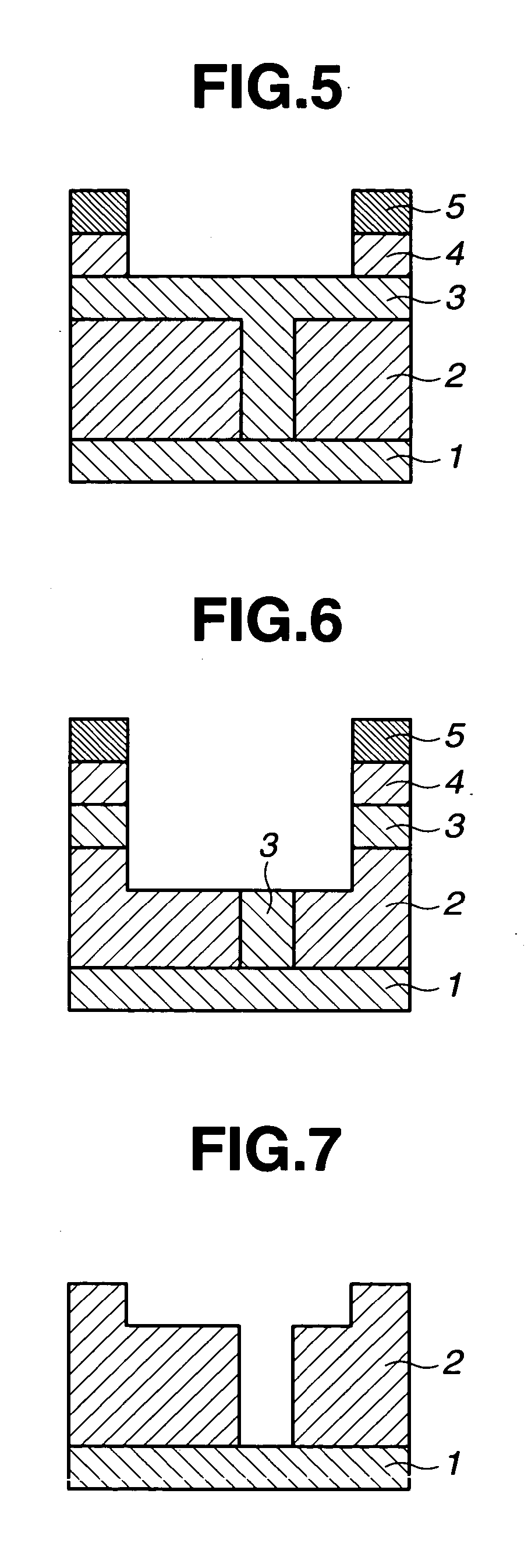Sacrificial film-forming composition, patterning process, sacrificial film and removal method
a technology of sacrificial film and composition, applied in the direction of instruments, photomechanical devices, optics, etc., can solve the problems of difficult to establish a satisfactory selective ratio and unlikely selectivity of silicon base materials
- Summary
- Abstract
- Description
- Claims
- Application Information
AI Technical Summary
Benefits of technology
Problems solved by technology
Method used
Image
Examples
preparation example 1
[0205] A 1-liter flask was charged with 152.5 g of ultrapure water, 297.5 g of ethanol and 14.9 g of a 25% tetramethylammonium hydroxide aqueous solution. In a nitrogen atmosphere and at 40° C., 157 g of 3,4-epoxycyclohexylethyltrimethoxysilane was added dropwise over 60 minutes. After 4 hours of ripening, 3.8 g of acetic acid was added to the reaction solution, from which ethanol and methanol were distilled off in a vacuum of 100 hPa. To the residue was added 475 g of ethyl acetate. The water layer was separated off, and the organic layer was washed with 120 g of ultrapure water, which procedure was repeated three times. To the organic layer was added 400 g of PGMEA. This solution was concentrated in a vacuum of 20 hPa, yielding 623 g of the solution. The nonvolatile content was 18.0 wt %. The silicone resin thus obtained had a weight average molecular weight of 3,600 as measured by GPC with polystyrene standards.
preparation example 2
[0206] A 500-ml flask was charged with 50 g of ultrapure water, 100 g of ethanol and 16.0 g of a 25% tetramethylammonium hydroxide aqueous solution. In a nitrogen atmosphere and at 40° C., a mixture of 7.4 g of 3,4-epoxycyclohexylethyltrimethoxysilane, 6.7 g of acetoxypropyltrimethoxysilane and 22.6 g of (2-methoxy-propoxy)propyltrimethoxysilane was added dropwise over 25 minutes. After 4 hours of ripening, 1.65 g of acetic acid was added to the reaction solution for neutralization, from which ethanol and methanol were distilled off in a vacuum of 100 hPa. To the residue was added 200 g of ethyl acetate. The water layer was separated off, and the organic layer was washed with 100 g of ultrapure water, which procedure was repeated three times. To the organic layer was added 180 g of PGMEA. This solution was concentrated in a vacuum of 20 hPa, yielding 170 g of the solution. The nonvolatile content was 13.6 wt %. The silicone resin thus obtained had a weight average molecular weight o...
preparation example 3
[0207] A 500-ml flask was charged with 50 g of ultrapure water, 100 g of ethanol and 5.0 g of a 25% tetramethylammonium hydroxide aqueous solution. In a nitrogen atmosphere and at 40° C., a mixture of 13.3 g of 3,3,3-trifluoropropyltrimethoxysilane, 11.1 g of glycidoxypropyltrimethoxysilane and 11.3 g of (2-methoxy-propoxy)propyltrimethoxysilane was added dropwise over 25 minutes. After 4 hours of ripening, 1.65 g of acetic acid was added to the reaction solution for neutralization, from which ethanol and methanol were distilled off in a vacuum of 100 hPa. To the residue was added 200 g of ethyl acetate. The water layer was separated off, and the organic layer was washed with 100 g of ultrapure water, which procedure was repeated three times. To the organic layer was added 200 g of PGMEA. This solution was concentrated in a vacuum of 20 hPa, yielding 160 g of the solution. The nonvolatile content was 14.8 wt %. The silicone resin thus obtained had a weight average molecular weight o...
PUM
| Property | Measurement | Unit |
|---|---|---|
| relative permittivity | aaaaa | aaaaa |
| thermal decomposition temperature | aaaaa | aaaaa |
| boiling point | aaaaa | aaaaa |
Abstract
Description
Claims
Application Information
 Login to View More
Login to View More - R&D
- Intellectual Property
- Life Sciences
- Materials
- Tech Scout
- Unparalleled Data Quality
- Higher Quality Content
- 60% Fewer Hallucinations
Browse by: Latest US Patents, China's latest patents, Technical Efficacy Thesaurus, Application Domain, Technology Topic, Popular Technical Reports.
© 2025 PatSnap. All rights reserved.Legal|Privacy policy|Modern Slavery Act Transparency Statement|Sitemap|About US| Contact US: help@patsnap.com



